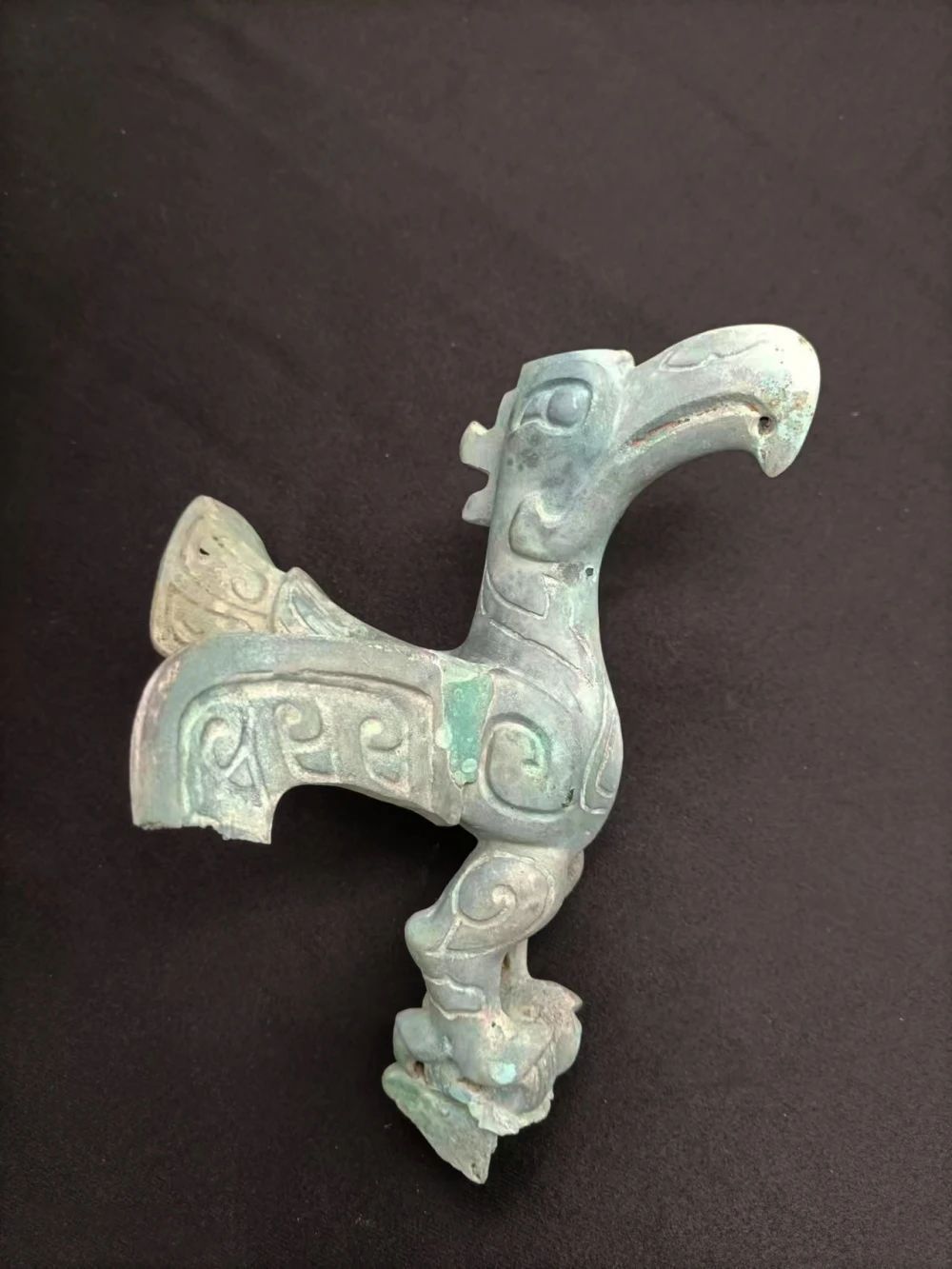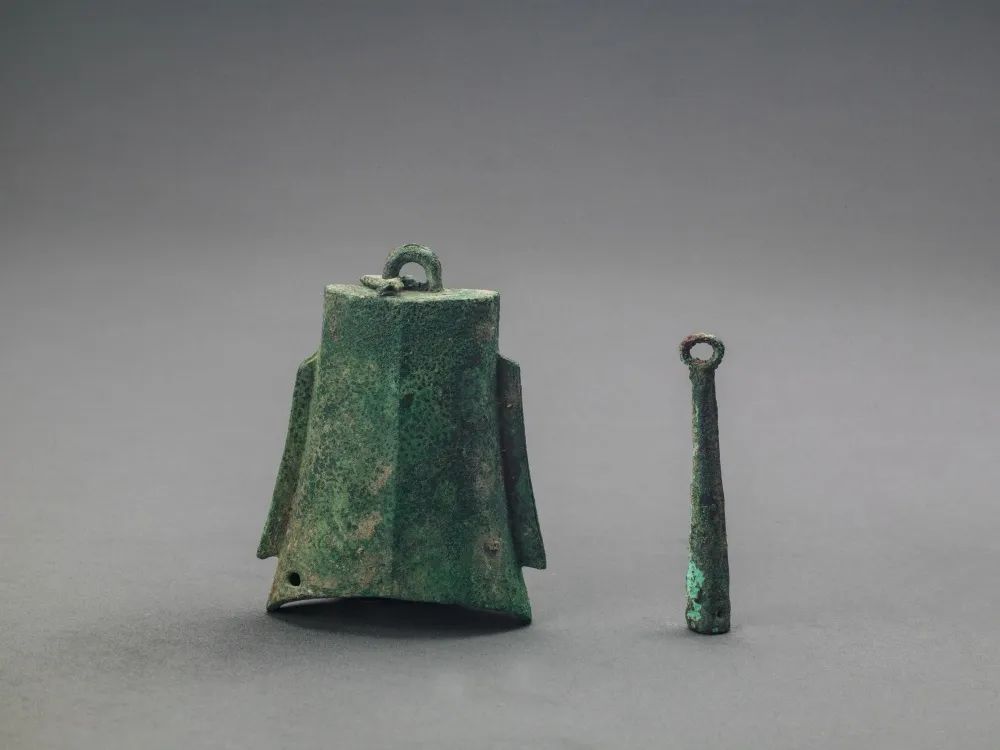· 商代后期(公元前 1300 年—前 1100 年)
· 宽60厘米,高78厘米
· 2021年出土于四川广汉三星堆遗址三号祭祀坑,K3QW:73
· 四川省文物考古研究院藏
· Late Shang Dynasty (1300B.C.-1100B.C.)
· W.60cm; H.78cm
· Unearthed from No.3 sacrificial pit at the Sanxingdui Site in Guanghan, Sichuan, in 2021,K3QW:73
· Collection of Sichuan Provincial Cultural Relics and Archaeology Research Institute
该青铜树枝由一残断树干及三分枝组成。三分枝分别向三个方向伸出,应为一层树枝。其中一树枝末端有残缺花朵,另外一树枝残缺严重,仅在下端见一环纽。
该青铜树枝应是青铜神树的一部分,神树连接天地,沟通人神,神灵缘此降世,巫师借此登天。神树可视作上古先民天地不绝、天人感应、人神互通之思维观念的形象化写照。世界各地古文明均有树崇拜,视“树”为“宇宙树”或“生命树”等,此文物对研究世界不同区域、不同民族、不同文明的交流互鉴具有重要意义。
The bronze tree branch consists of a broken trunk and three branching parts. The three branching parts, extending toward three different directions, should be in one layer. One part has incomplete flowers at the end, while another is severely damaged, with only a loop handle at its lower end.
This bronze tree branch should be a part of a bronze sacred tree, which was believed to connect heaven and earth and served as a medium between human beings and deities. Deities descended to earth, and sorcerers ascended to heaven along such sacred trees. Bronze sacred trees crystalized the ideas of the ancient ancestors who believed in the immortality of heaven and earth, the communion between human beings and heaven, and the communication between human beings and deities. Tree worship was a widespread phenomenon in ancient civilizations worldwide, where trees were viewed as symbols of the universe and life, playing an important role in the studies of the exchanges and mutual learning among different regions, ethnic groups, and civilizations.
青铜鸟

· 商代后期(公元前1300年—前1100年)
· 长13.5厘米,宽11.5厘米,高19厘米
· 2021年出土于四川广汉三星堆遗址七号祭祀坑,K7QW:T-845
· 四川省文物考古研究院藏
· Late Shang Dynasty (1300B.C. - 1100B.C.)
· L.13.5cm; W.11.5cm; H.19cm
· Unearthed from No.7 sacrificial pit at the Sanxingdui Site in Guanghan, Sichuan, in 2021,K7QW:T-845
· Collection of Sichuan Provincial Cultural Relics and Archaeology Research Institute
昂首前视,双翼展翅,作飞跃状,翅膀部分残断。头顶中空,短颈,圆眼,作鹰嘴状钩喙,喙上有一圆孔。鸟身较小,鸟尾上翘。鸟身、腿均饰卷云纹。很有可能是安装在类似于青铜神树上的饰物。在三星堆遗址出土的文物中,一个非常引人注目的现象就是在所有的人和动物造型中,鸟的造型受到了异乎寻常的关注,古蜀人塑造了大量不同材质、造型的鸟的形象、模仿成鸟的人的形象以及人首鸟身的神的形象,以表达他们对鸟的敬奉和崇拜。青铜神树上的青铜鸟,应与古蜀人的太阳崇拜有关。
The bronze bird holds it head high and looks forward. Its wings, which are partially broken, are spread out as if it is flying. It has a hollowed-out head, a short neck, round eyes, and a beak in the shape of a hooked bill of an eagle. There is a round hole on the beak. The bird's body is relatively small, and its tail is curved upwards. Both the body and legs are decorated with Juanyun Wen (卷云纹, curling-cloud pattern). Probably the bird was mounted on a bronze sacred tree as an ornament. Among the cultural relics unearthed from the Sanxingdui Site, an eye-catching phenomenon is that among all human and animal statues, birds seem to have received extraordinary attention. The ancient Shu people created a large number of birdshaped objects with different materials and styles, including bird-like human figures and deities with bird heads and human bodies, expressing their reverence and worship for birds. The bronze bird on bronze sacred tree is likely associated with the sun worship of the ancient Shu people.
青铜铃

· 商代后期(公元前1300年—前1100年)
· 宽6.8厘米,高9厘米,厚3.6厘米
· 1986年出土于四川广汉三星堆遗址二号祭祀坑,K2②:79-31
· 四川广汉三星堆博物馆藏
· Late Shang Dynasty(1300B.C. - 1100B.C.)
· W.6.8cm; H.9cm; T.3.6cm
· Unearthed from No. 2 sacrificial pit at the Sanxingdui Site in Guanghan, Sichuan, in 1986, K2 ② :79-31
· Collection of Sanxingdui Museum
正面略呈梯形,上小下大,顶部的半圆形纽系作悬挂之用。铃身两侧有长而薄的翼,横断面呈椭圆形。铃舌呈柱状,上端小环与铃身内顶小环相套。
三星堆遗址出土青铜铃类型众多,如饰有兽面纹的编钟形青铜铃、波浪纹的花果形青铜铃等,同青铜挂饰、金箔饰片等器物功用类似,可能是神树上的装饰物件。
The bell's front side is of a slightly trapezoidal shape, with a small top and a large bottom. On its top, a semi-circular knob is used for suspension. The bell's two sides have long and thin wings with oval cross sections. The bell's cylindrical clapper has a small loop on its upper end, allowing it to be fitted with another small loop on the bell body's inner top.
Many types of bronze bells have been excavated from Sanxingdui, including chime-shaped bronze bell with animal-face pattern and flower-and-fruit-shaped bronze bell with wave pattern. These bells share similar usages with bronze hanging decorations and gold foil decorations.They are probably decorative objects hung on bronze sacred trees.
展览时间:
2023年12月13日至2024年2月1日
展览地点:
上海大学博物馆一层临展厅
(上海市宝山区南陈路333号)
开放时间:
周一至周日8:30-16:30(16:00停止入馆)

